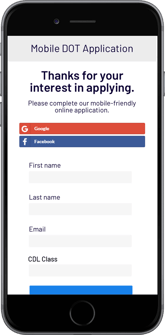As a driver recruiter or executive in the trucking industry, you know first-hand how dire the driver shortage is today.
Thanks to an ongoing uptick in the economy coupled with an aging workforce, the demand for qualified drivers has never been higher. Unfortunately, there are less new drivers entering the industry as those who are leaving or retiring, which means the competition to attract and retain available drivers is through the roof.
Companies must look to new, innovative solutions to help them create a seamless, enjoyable applicant process to attract new driving talent – and see potential drivers through the entire application and hiring process so they aren’t lost to the competition.
Stagnant trucks don’t help your business grow or allow you to stay competitive. The only way to grow and expand fleets is to get qualified drivers into trucks and onto roads.
For most companies, getting drivers to take initial interest in their company is easy – it’s what happens after a candidate clicks ‘Apply Now’ that can make or break a new recruit. In this article, we’ll take a look at 3 proven ways to thrive in today’s driver shortage environment.
 1) Create an Optimized Applicant Experience
1) Create an Optimized Applicant ExperienceOnce a driver clicks that ‘Apply Now’ button, they begin an organization’s application process. Companies must remember to consider this recruiting process from the driver’s viewpoint. It’s critical to make sure that the applicant’s experience is a positive one. Drivers faced with a lengthy or clunky online application process won’t make it all the way through, leading to
abandonment. That is not a good experience for anyone.
There are few straightforward ways companies can optimize their applicant experience for drivers, starting with a mobile-friendly DOT application. In today’s modern world, the application MUST be easy to complete on a mobile phone.
The use of text messaging can also be a major differentiator for companies looking to stand out. Recruiters that have a hard time getting drivers to answer their phone should consider following up with a simple text message to ensure they connect with the driver. You’d be amazed at the response rate of a text message versus answering an unexpected call.
Next, recruiters should make sure their DOT application or lead form are as brief and concise as possible. If drivers have to spend too much time filling out a form, they’ll opt to apply to another company that has an easier process. Or worse, if they’re expected to download, print, and sign a PDF, they’ll abandon the process. They just can’t do that effectively from a mobile phone.
With so much competition, drivers apply to several different companies at once, which is why the recruitment process must be as efficient and as painless as possible. Making application forms easy to locate, easy to fill out, and easy to submit is a great starting point. Additionally, savvy recruiters have found success by filling out forms on behalf of candidates while they’re on the phone, and then sending the completed document to the driver for a simple review and signature. This not only eliminates waiting on the driver to fill out the application, but it ensures that the content is completed properly.
Finally, companies should think about different ways to reduce form abandonment. If a driver has been on the company’s site more than once, consider auto-filling some of the form fields with his or her information. These drivers are potential assets to your organization, which makes it that much more important to ease them through the application process. Make sure there are processes and workflows in place to help reduce abandonment rates and encourage drivers to finalize the application process.
2) Embrace the Importance of Human Interaction
Even though drivers apply online, transportation is just like every other industry – there must be some level of human  interaction. People like to feel as though they’re important, valued, and play a critical role
interaction. People like to feel as though they’re important, valued, and play a critical role
in the organization they represent. In the world of trucking in which most recruiters only hire 1-2 out of every 10 applicants, establishing a method of person-to-person contact
right away is critical.
Typically, new driver leads come through to recruiters in one of two ways: an inbound call
or a form fill. Let’s break down these two processes and examine how personal, human interaction can help move these drivers through the recruiting process.
First, let’s look at inbound calls. Any time the phone rings, recruiters must answer - never let the call go to a voicemail. Drivers may only try calling once before they move onto your competition. Recruiters should always make sure they get contact information from the applicant before hanging up. At the very least, they should collect:
- Full Name
- Phone number (preferably mobile number)
- Email address
Each phone call should be handled as if the driver is sitting across the desk – the recruiter should answer with a smile, speak enthusiastically, pay attention when the driver talks, and make him or her feel as though they’re the only person that matters at that moment.
Recruiters should also be prepared with important company-specific information and benefits (compensation plan, average tenure, age of equipment, etc.) in order to “sell” the driver on why they should work there. After all, RECRUITING IS SALES. It’s also important to be honest and upfront about what to expect from the job.
When it comes to following up on completed form fills, the recruiting process can be tricky. Recruiters must call the driver immediately, yet even so, they’ll likely be stuck leaving a voicemail. This is okay, as long as it’s supplemented with other methods of communication, like text messaging. Recruiters must be proactive and assertive, or else these leads will disappear. If the recruiter has to leave a voicemail, have them send a follow-up text with similar content to ensure that the message is received. The more channels recruiters use to engage drivers, the more successful they’ll be.
No matter how a new lead comes in, recruiters should not waste any time getting the driver into the applicant process. Even if it takes walking him or her through the DOT application while on the phone or sending multiple follow-up texts, it’s key to keep engaging with the driver throughout the qualification process.
3) Leverage Easy-to-Use Technology
When it comes to modern driving recruiting, there is no way recruiters can be in constant contact with every driver in their database at the same time. This is why CRM platforms are so important for long-term recruitment success. By feeding all prospects, leads, and current drivers through a CRM platform, recruiters can visualize all the data points and information relevant to specific drivers, pinpoint where they are in the recruiting process, and take note of outstanding issues related to that driver.
Not only does CRM make applicant tracking easier, it also helps recruiters be more efficient. Recruiters can automate monthly newsletters to their database, send emails and texts to drivers currently in the application process, and even create targeted drip campaigns to any variety of drivers. CRM platforms help put hours back in the day for recruiters, which in turn can help them attract more prospects and build a more efficient organization in today’s competitive environment.
If you’re ready to start proactively addressing the driver shortage, let DriverReach provide the resources and solutions necessary to help. With DriverReach, CDL recruiters can seamlessly move prospects through the recruiting process, engage prospects one-on-one, and leverage back-end analytics to close the loop.

